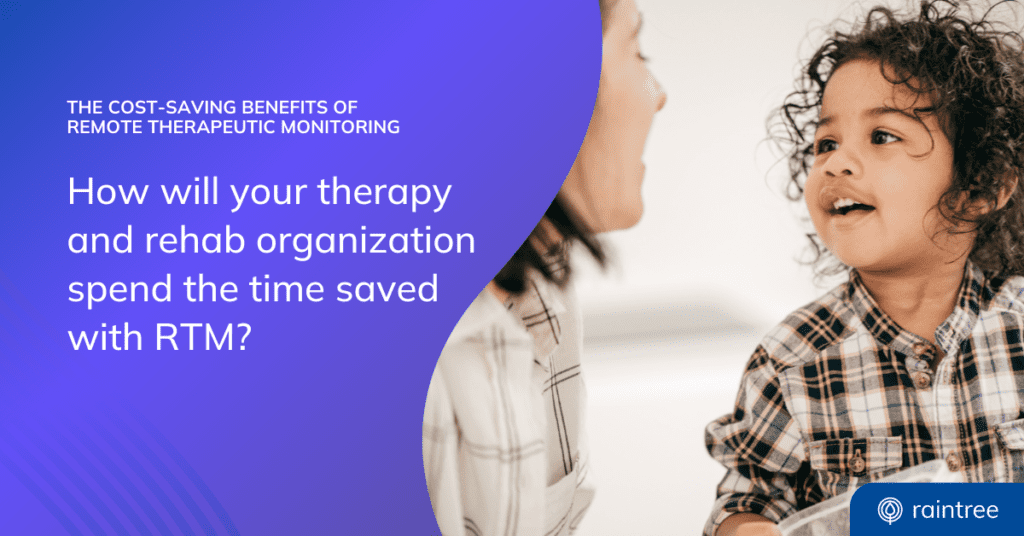Remote therapeutic monitoring (RTM) leverages technology to collect and analyze self-reported patient data to assess the outcomes in real time.
Unlike remote patient monitoring (RPM), which transmits physiological data—like blood pressure—RTM collects information like pain levels or treatment adherence. This information helps clinicians track patient progress and adjust treatment, faster.
But what are the business benefits of remote therapeutic monitoring (RTM)? Let’s take a closer look at how RTM can help you elevate your level of care and cut costs.
Streamline Medical Documentation to Reduce Healthcare Costs
Although a critical part of every clinical process, quality documentation has been an age-old struggle that takes up too much time and increases costs. With the right digital solution, however, you can take advantage of tailorable built-in templates that go hand-in-hand with your RTM patients. To take it a step further, a truly excellent template will also ensure you have room for provider notes and other clinical paperwork, allowing for faster documentation than ever.
Another upside of remote therapeutic monitoring is that with the help of high-level automation and integration, updating patient records can become an effortless process. Since most RTM equipment stores data electronically, you can quickly and safely transfer the information into a patient’s history rather than physically filling every field in the record.
As an added bonus to integrating RTM into your practice, you can reduce staff workload while increasing your reimbursements. Considering that providers spend an average of 4.5 hours a day completing patient records, a digital solution that can tackle the pain points of clinical documentation is especially crucial in lessening the burden on medical professionals.
Reduce In-Person Office Visits with RTM CPT Codes
Most RTM cases only need to be monitored through physical appointments every 30 days, depending on the patient and the treatment. For example:
-
- CPT 98980 only requires at least one interactive meeting with the patient or caregiver within a calendar month
-
- CPT 98976 is only billed once every 30 days
In such cases, you can significantly reduce the number of appointments that were previously often scheduled to check the patient’s progress so long as your patient does not report any additional concerns that need to be addressed.
Thanks to reduced in-person visits for returning patients, the time freed up can be used for other unique patients needing more interactive interventions, ultimately increasing the number of unique paying patients coming to your practice. Moreover, cutting off unnecessary visits makes treatment more accessible for the elderly, low-income patients, and clients in rural areas who struggle to find organizations accepting new patients.
Remote Monitoring Improves Patient Experiences
The backbone of your practice is forged with satisfied patients, so any opportunity to improve patient experiences is time well-spent. As mentioned, remote therapeutic monitoring helps reduce in-person visits for patients with RTM devices. For patients, this translates to reduced travel costs and stress during their treatment, contributing to increased overall satisfaction with their care plan.
Beyond the convenience that RTM offers patients, this new technology also helps you adjust treatment plans more accurately and faster than before. Although physical appointments are reduced, patient data is still constantly generated and transmitted to the provider, facilitating deeper insight into patient progress, realistic goal setting, and timely treatment plan adjustment.
What’s more, you would have questionnaires within your RTM software that allow you to track patient progress and evaluate their outcomes. You could also set the software to trigger particular workflows or update the plan of care as you move forward. As you can see, the patient remains proactive in the entire process while maintaining minimal physical intervention through lots of automated support from the provider’s end.
So what’s the big picture? Simply put, RTM promotes happier, more proactive patients, keeping your schedule full and nurturing a healthier community.
Experience the Benefits of Remote Therapeutic Monitoring
If you’re struggling to implement RTM into your therapy and rehab practice without disrupting your processes, look no further than Raintree’s all-in-one EMR system. Raintree offers configurable templates that let you input custom fields according to the practice or patient category, eliminating cumbersome paperwork and enabling therapists to fill out documents faster. From documentation efficiencies to reduced in-person visits and extra time to help more patients, the benefits of an EMR that caters to RTM can reduce overhead costs, improve patient outcomes, and transform your practice.
Sign up for a free demo with Raintree today to see how we can help you take your organization to the next level!


